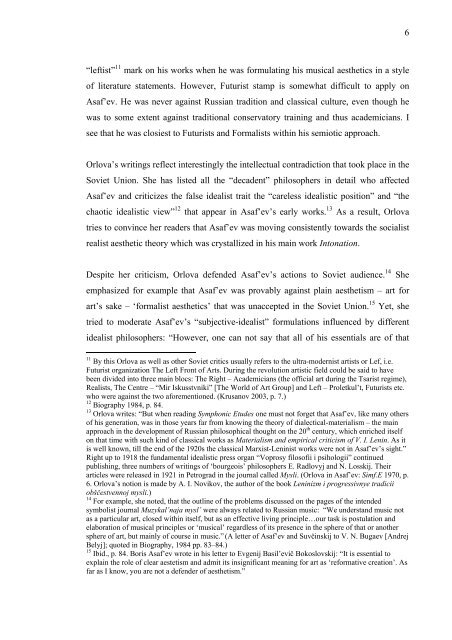Boris Asaf'ev and the Soviet Musicology - E-thesis
Boris Asaf'ev and the Soviet Musicology - E-thesis
Boris Asaf'ev and the Soviet Musicology - E-thesis
You also want an ePaper? Increase the reach of your titles
YUMPU automatically turns print PDFs into web optimized ePapers that Google loves.
“leftist” 11 mark on his works when he was formulating his musical aes<strong>the</strong>tics in a style<br />
of literature statements. However, Futurist stamp is somewhat difficult to apply on<br />
Asaf’ev. He was never against Russian tradition <strong>and</strong> classical culture, even though he<br />
was to some extent against traditional conservatory training <strong>and</strong> thus academicians. I<br />
see that he was closiest to Futurists <strong>and</strong> Formalists within his semiotic approach.<br />
Orlova’s writings reflect interestingly <strong>the</strong> intellectual contradiction that took place in <strong>the</strong><br />
<strong>Soviet</strong> Union. She has listed all <strong>the</strong> “decadent” philosophers in detail who affected<br />
Asaf’ev <strong>and</strong> criticizes <strong>the</strong> false idealist trait <strong>the</strong> “careless idealistic position” <strong>and</strong> “<strong>the</strong><br />
chaotic idealistic view” 12 that appear in Asaf’ev’s early works. 13 As a result, Orlova<br />
tries to convince her readers that Asaf’ev was moving consistently towards <strong>the</strong> socialist<br />
realist aes<strong>the</strong>tic <strong>the</strong>ory which was crystallized in his main work Intonation.<br />
Despite her criticism, Orlova defended Asaf’ev’s actions to <strong>Soviet</strong> audience. 14 She<br />
emphasized for example that Asaf’ev was provably against plain aes<strong>the</strong>tism – art for<br />
art’s sake – ‘formalist aes<strong>the</strong>tics’ that was unaccepted in <strong>the</strong> <strong>Soviet</strong> Union. 15 Yet, she<br />
tried to moderate Asaf’ev’s “subjective-idealist” formulations influenced by different<br />
idealist philosophers: “However, one can not say that all of his essentials are of that<br />
11 By this Orlova as well as o<strong>the</strong>r <strong>Soviet</strong> critics usually refers to <strong>the</strong> ultra-modernist artists or Lef, i.e.<br />
Futurist organization The Left Front of Arts. During <strong>the</strong> revolution artistic field could be said to have<br />
been divided into three main blocs: The Right – Academicians (<strong>the</strong> official art during <strong>the</strong> Tsarist regime),<br />
Realists, The Centre – “Mir Iskusstvniki” [The World of Art Group] <strong>and</strong> Left – Proletkul’t, Futurists etc.<br />
who were against <strong>the</strong> two aforementioned. (Krusanov 2003, p. 7.)<br />
12 Biography 1984, p. 84.<br />
13 Orlova writes: “But when reading Symphonic Etudes one must not forget that Asaf’ev, like many o<strong>the</strong>rs<br />
of his generation, was in those years far from knowing <strong>the</strong> <strong>the</strong>ory of dialectical-materialism – <strong>the</strong> main<br />
approach in <strong>the</strong> development of Russian philosophical thought on <strong>the</strong> 20 th century, which enriched itself<br />
on that time with such kind of classical works as Materialism <strong>and</strong> empirical criticism of V. I. Lenin. As it<br />
is well known, till <strong>the</strong> end of <strong>the</strong> 1920s <strong>the</strong> classical Marxist-Leninist works were not in Asaf’ev’s sight.”<br />
Right up to 1918 <strong>the</strong> fundamental idealistic press organ “Voprosy filosofii i psihologii” continued<br />
publishing, three numbers of writings of ‘bourgeois’ philosophers E. Radlovyj <strong>and</strong> N. Losskij. Their<br />
articles were released in 1921 in Petrograd in <strong>the</strong> journal called Mysli. (Orlova in Asaf’ev: Simf.E 1970, p.<br />
6. Orlova’s notion is made by A. I. Novikov, <strong>the</strong> author of <strong>the</strong> book Leninizm i progressivnye tradicii<br />
obščestvennoj mysli.)<br />
14 For example, she noted, that <strong>the</strong> outline of <strong>the</strong> problems discussed on <strong>the</strong> pages of <strong>the</strong> intended<br />
symbolist journal Muzykal’naja mysl’ were always related to Russian music: “We underst<strong>and</strong> music not<br />
as a particular art, closed within itself, but as an effective living principle…our task is postulation <strong>and</strong><br />
elaboration of musical principles or ‘musical’ regardless of its presence in <strong>the</strong> sphere of that or ano<strong>the</strong>r<br />
sphere of art, but mainly of course in music.” (A letter of Asaf’ev <strong>and</strong> Suvčinskij to V. N. Bugaev [Andrej<br />
Belyj]; quoted in Biography, 1984 pp. 83–84.)<br />
15 Ibid., p. 84. <strong>Boris</strong> Asaf’ev wrote in his letter to Evgenij Basil’evič Bokoslovskij: “It is essential to<br />
explain <strong>the</strong> role of clear aestetism <strong>and</strong> admit its insignificant meaning for art as ‘reformative creation’. As<br />
far as I know, you are not a defender of aes<strong>the</strong>tism.”<br />
6

















